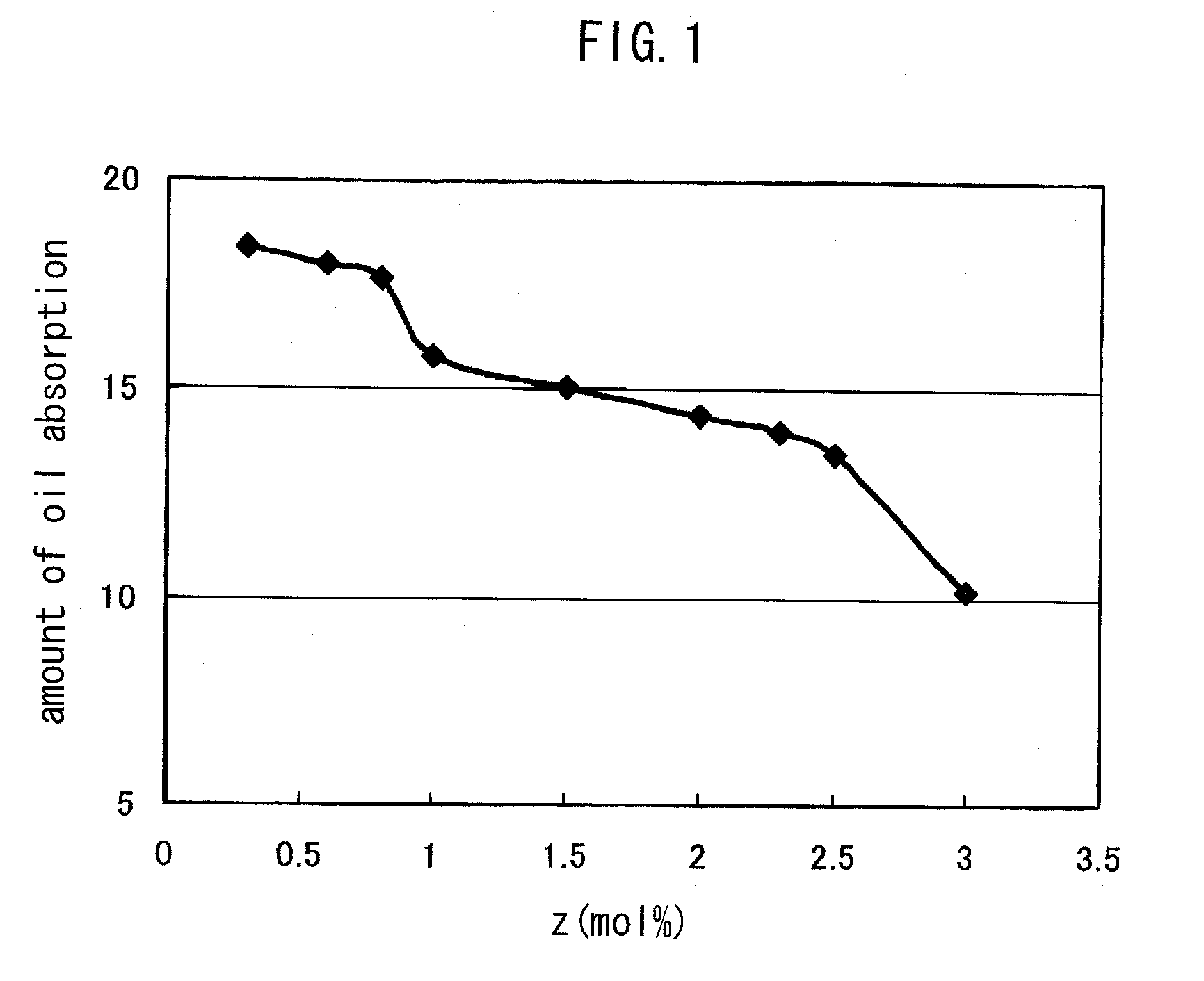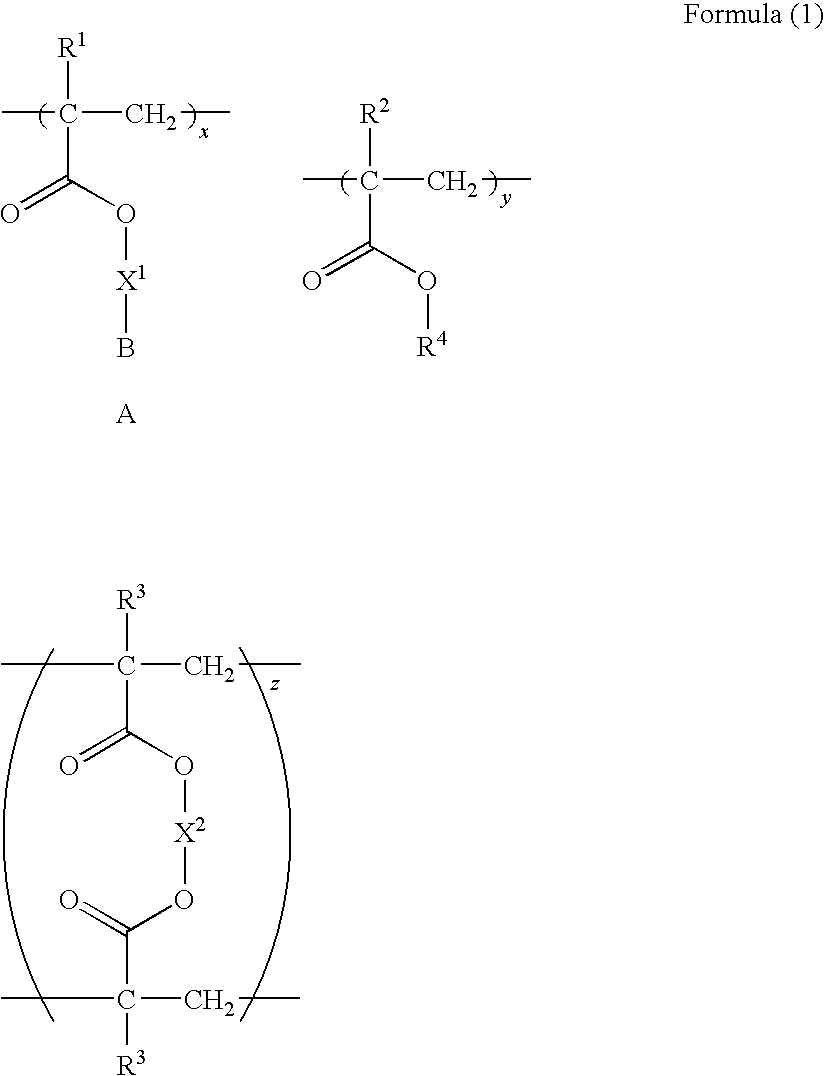Polymer compound and oil absorbent
a technology of oil absorbent and polymer compound, which is applied in the direction of other chemical processes, chemistry apparatuses and processes, etc., can solve the problems of insufficient absorbents for practical use, inconvenient handling of most conventional oil absorbents, and the controversy of the recovery performance of marine spillage oil or waste oil
- Summary
- Abstract
- Description
- Claims
- Application Information
AI Technical Summary
Benefits of technology
Problems solved by technology
Method used
Image
Examples
synthetic example 1
Synthesis of Monomer
[0151]The following compound-1 was synthesized according to the following scheme.
(Step 1)
[0152]A mixture of 3-bromo-1-propanol (the above compound-1a) (19.9 g, 143 mmol) and tri-n-dodecylamine (149 g, 286 mmol) was stirred without solvent at 120° C. for 9 hours. After a white solid obtained by being cooled to room temperature was filtered, the white solid washed with ethyl acetate, and compound-1b was obtained quantitatively.
(Step 2)
[0153]The thus obtained compound-1b (31.4 g, 47.5 mmol) and 5.77 g (57.0 mmol) of triethylamine were dissolved in 147 ml of methylene chloride, and 5.46 g (52.2 mmol) of methacryloyl chloride was added thereto dropwise slowly with ice-cold cooling under a nitrogen atmosphere. After stirring at room temperature for 2 hours, 200 ml of water was added thereto, and a liquid separatory operation was performed. Thereafter, the solvent was distilled away, and compound-1c was obtained.
(Step 3)
[0154]The thus obtained compound-1c (26.9 g, 36.9 ...
synthetic example 2
Synthesis of Monomer
[0155]The following compound-2 was synthesized according to the following scheme.
[0156](Step 1)
[0157]The above compound-2a (10.0 g, 122 mmol) was dissolved in 240 ml of tetrahydrofuran (THF) solvent, thereafter, 4.87 g (122 mmol) of sodium hydride was slowly added thereto with stirring with ice-cold cooling under a nitrogen atmosphere, and the mixture was stirred with ice-cold cooling for 30 minutes. After adding 42.6 g (128 mmol) of 1-bromooctadecane thereto at room temperature, the mixture was stirred at 60° C. for 4 hours. After 300 ml of water was added to the reaction solution, an extraction was performed with ethyl acetate, and the extract was washed with saturated sodium chloride solution, and was dried with anhydrous magnesium sulfate. After distilling away the solvent, the product was purified with silica gel column chromatography (solvent: hexane / ethyl acetate=10 / 1), and 40.7 g of compound-2b was obtained.
[0158](Step 2)
[0159]The compound-2b (40.1 g, 120...
example 1
Preparation of Polymer Gel 1
[0164]An oil absorptive polymer gel 1 was prepared by the solution polymerization method as described below.
[0165]As a monomer, 1.89 g (1.95 mmol) of the compound-1 synthesized in the synthetic example 1 (x=29.7 mole % in Formula (1)), 1.54 g (4.55 mmol) of octadecyl methacrylate (y=69.3 mole %), and 12.9 mg (0.065 mmol) of ethyleneglycol dimethacrylate (z=1.0 mole %) as a cross-linking agent were dissolved in 3 ml of degassed toluene, and the mixture was stirred at room temperature under a nitrogen atmosphere for 15 minutes. Thereafter, 16.1 mg (0.065 mmol) of V-65 ((trade name) manufactured by Wako Pure Chemical Industries, Ltd.) as a polymerization initiator was added to the reaction solution, and the mixture was stirred at 60° C. under a nitrogen atmosphere for 5 hours.
[0166]Thereafter, the thus obtained gel was washed with toluene, and was subjected to vacuum drying with heating, and a dry solid product of gel (polymer gel 1) was obtained.
[0167]
[0168...
PUM
| Property | Measurement | Unit |
|---|---|---|
| dielectric constant | aaaaa | aaaaa |
| temperature | aaaaa | aaaaa |
| temperature | aaaaa | aaaaa |
Abstract
Description
Claims
Application Information
 Login to View More
Login to View More - R&D
- Intellectual Property
- Life Sciences
- Materials
- Tech Scout
- Unparalleled Data Quality
- Higher Quality Content
- 60% Fewer Hallucinations
Browse by: Latest US Patents, China's latest patents, Technical Efficacy Thesaurus, Application Domain, Technology Topic, Popular Technical Reports.
© 2025 PatSnap. All rights reserved.Legal|Privacy policy|Modern Slavery Act Transparency Statement|Sitemap|About US| Contact US: help@patsnap.com



